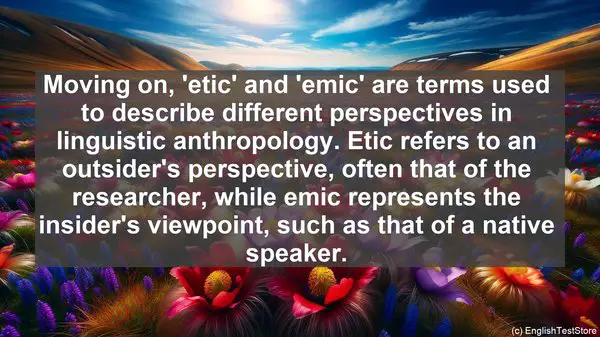Introduction
Welcome to today’s lesson on linguistic anthropology. In this lesson, we’ll be discussing the top 10 commonly confused words in this fascinating field. Let’s dive in!
1. Phonetics vs. Phonology
The first pair of words that often cause confusion are ‘phonetics’ and ‘phonology.’ While both deal with sounds in language, phonetics focuses on the physical properties of sounds, such as their production and perception, while phonology examines how sounds function within a particular language system.
2. Synchronic vs. Diachronic
Next, we have ‘synchronic’ and ‘diachronic.’ Synchronic refers to the study of a language at a particular point in time, analyzing its structure and usage. On the other hand, diachronic looks at the historical development and changes in a language over time.
3. Etic vs. Emic
Moving on, ‘etic’ and ’emic’ are terms used to describe different perspectives in linguistic anthropology. Etic refers to an outsider’s perspective, often that of the researcher, while emic represents the insider’s viewpoint, such as that of a native speaker.

4. Lexicon vs. Grammar
When studying a language, it’s important to differentiate between ‘lexicon’ and ‘grammar.’ The lexicon encompasses the vocabulary, the words and their meanings, while grammar focuses on the rules and structures that govern how those words are combined and used.
5. Dialect vs. Accent
While often used interchangeably, ‘dialect’ and ‘accent’ have distinct meanings. A dialect refers to a variety of a language that differs in vocabulary, pronunciation, and grammar, while an accent relates to the way someone pronounces words within a particular dialect or language.
6. Descriptive vs. Prescriptive
In linguistic anthropology, we encounter the terms ‘descriptive’ and ‘prescriptive.’ Descriptive linguistics aims to objectively describe how a language is used by its speakers, while prescriptive linguistics focuses on establishing norms and rules for ‘correct’ language usage.
7. Pidgin vs. Creole
When discussing contact languages, ‘pidgin’ and ‘creole’ are often mentioned. A pidgin is a simplified language that emerges as a means of communication between groups with different native languages. If a pidgin becomes the native language of a community, it is then considered a creole.
8. Ethnography vs. Ethnology
In the realm of cultural anthropology, we come across ‘ethnography’ and ‘ethnology.’ Ethnography involves the firsthand, immersive study of a particular culture, often through fieldwork, while ethnology is the comparative analysis of different cultures based on ethnographic data.
9. Homonyms vs. Homophones
Language is full of words that sound alike but have different meanings. ‘Homonyms’ are words that are spelled and pronounced the same but have different meanings, while ‘homophones’ are words that sound the same but may have different spellings and meanings.

10. Morpheme vs. Phoneme
Lastly, let’s clarify the difference between ‘morpheme’ and ‘phoneme.’ A morpheme is the smallest meaningful unit in a language, such as a word or a prefix, while a phoneme is the smallest distinctive sound unit that can change the meaning of a word.
